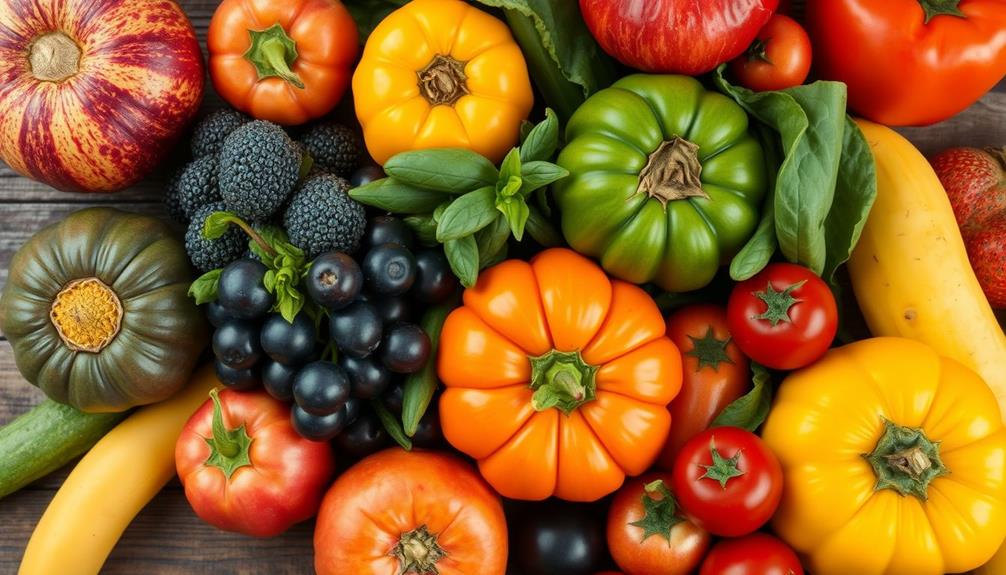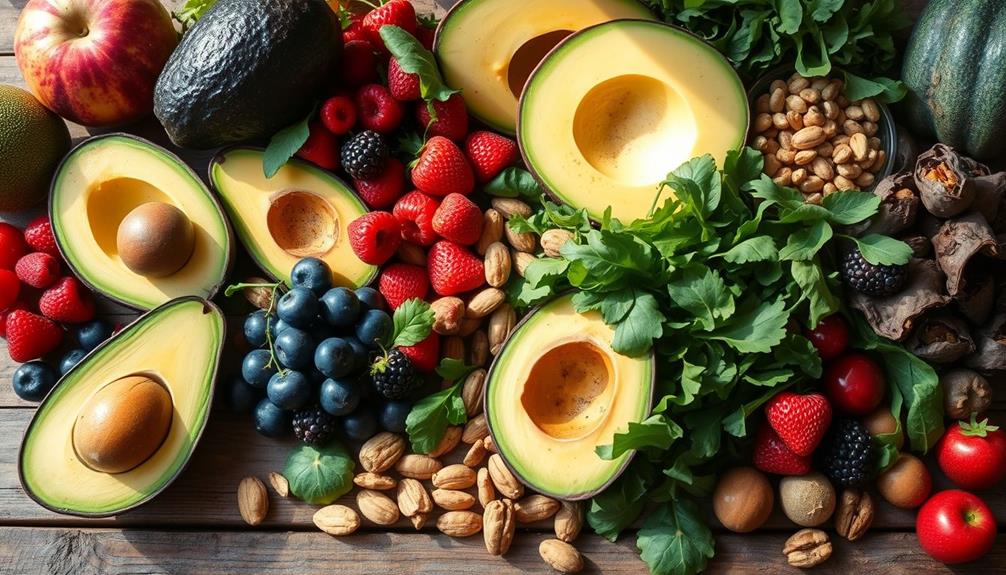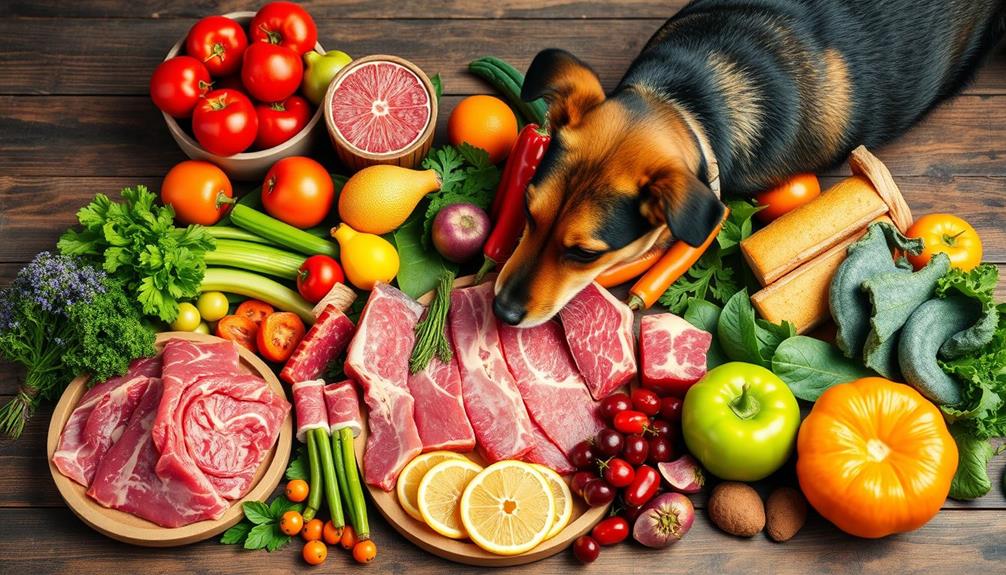Raw food is food that's uncooked and unprocessed, meaning it hasn't been heated above 115°F. You'll find fresh fruits, vegetables, nuts, seeds, and even sprouted grains in this diet, all emphasizing their natural flavors and nutrients. Many believe that raw foods boost health and promote better digestion by retaining beneficial enzymes. However, it's important to keep in mind the potential risks, like foodborne illnesses and nutrient deficiencies. If you're interested in incorporating more raw foods into your meals or understanding the benefits and drawbacks, there's plenty more to explore about this vibrant dietary choice.
Key Takeaways
- Raw food refers to uncooked items not heated above 48°C (115°F), preserving natural enzymes and nutrients.
- The diet includes fresh fruits, vegetables, nuts, seeds, and may incorporate unprocessed dairy.
- Advocates claim raw foods enhance health, digestion, and nutrient absorption with lower risks of chronic diseases.
- Potential nutritional risks include deficiencies in vitamin B12, iron, and calcium, particularly in strict raw diets.
- Food safety is crucial due to higher risks of foodborne illnesses; proper washing and handling of raw foods are essential.
Definition of Raw Food
Raw food refers to uncooked foods that aren't heated above 48°C (115°F), which helps preserve their natural enzymes and nutrients. These uncooked foods include fresh fruits, vegetables, nuts, seeds, and certain dairy products, all of which are typically unrefined and unprocessed.
The raw food movement has gained traction in recent years, largely due to the growing awareness of the health benefits associated with consuming unprocessed foods. Additionally, raw foods often promote enhanced nutrient absorption and support digestive health, making them an appealing choice for those looking to improve their overall well-being.
One key aspect of raw food diets is the belief that cooking can destroy beneficial natural enzymes, which many advocates argue are essential for ideal nutrition. By sticking to raw foods, you're likely to enjoy a higher intake of vitamins and minerals that can be diminished through cooking.
This focus on unprocessed foods not only enhances the nutritional profile of your meals but also encourages you to explore a variety of flavors and textures that raw ingredients offer.
Whether you're considering a raw food diet or simply want to incorporate more uncooked foods into your meals, understanding what raw food truly means can help you make informed choices for your health and well-being.
Health Claims and Risks
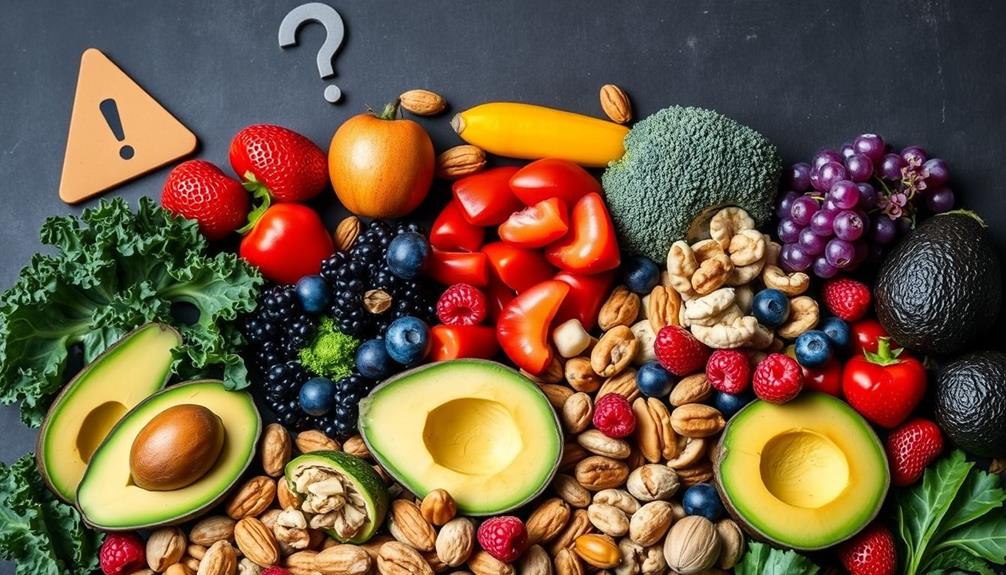
Embracing a raw food diet often brings with it a mix of health claims and potential risks that deserve careful consideration. Advocates believe that raw foods preserve beneficial natural enzymes and nutrients, enhancing overall health and digestion. Additionally, some proponents suggest that incorporating natural remedies alongside raw foods may offer further health benefits, such as reducing cold symptoms.
However, it's essential to weigh these claims against certain risks.
- Increased exposure to foodborne illness, such as E. coli and salmonella
- Potential nutrient deficiencies from a strictly raw diet
- Higher pesticide exposure from unprocessed fruits and vegetables
- Limited caloric intake compared to cooked foods
- Debate over the nutrient content and bioavailability of certain vitamins
While research indicates that raw foods can boost nutrient intake, critics argue that cooking provides survival advantages, offering higher caloric intake and improved nutrient bioavailability.
A study from Harvard University suggests that food processing, including cooking, played a significant role in human development and nutrition. Consequently, moderation is key when incorporating raw foods into your diet.
Balancing raw and cooked foods may help you enjoy the health benefits while minimizing risks associated with foodborne illnesses and nutrient deficiencies.
Components of Raw Food Diet
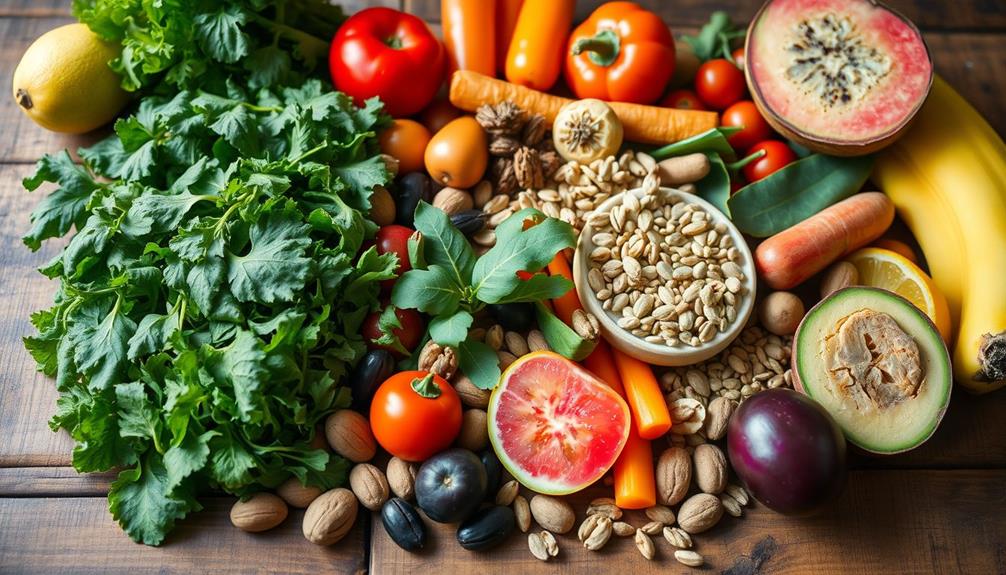
At the heart of a raw food diet lies a variety of unheated foods that aren't cooked above 48°C (115°F). You'll find fresh fruits and vegetables, nuts, seeds, and sprouted grains as the primary components. These foods are celebrated for their vibrant flavors and rich nutrient profiles.
Many raw food enthusiasts also incorporate certain unprocessed items, such as cold-pressed oils and dried fruits, as long as they haven't been subjected to high temperatures. Including items like nutrient-rich juices can further enhance the benefits of a raw food diet.
If you lean towards a plant-based approach, you'll likely focus solely on fruits, vegetables, nuts, and sprouted grains. However, some people include unpasteurized dairy, raw eggs, and even fish.
Preparation methods in a raw food diet often involve juicing, blending, dehydrating, soaking, and sprouting to enhance texture and taste without cooking.
Emphasizing organic and unprocessed foods is essential in this diet to maximize nutrient retention and reduce pesticide exposure. By sticking to these principles, your raw food diet can be not only delicious but also beneficial for your overall health.
Scientific Perspectives on Raw Foods
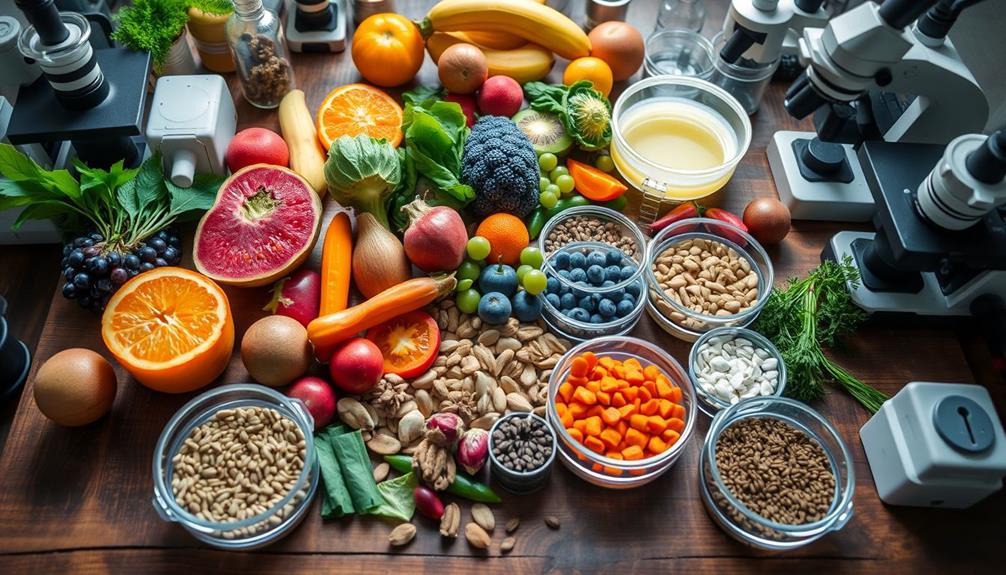
When you explore raw foods, you'll find a mix of nutritional benefits and drawbacks that can affect your health.
While some nutrients stay intact in raw items, others may be harder for your body to absorb.
Additionally, certain raw foods can provide natural remedies, such as essential oils that offer essential oil benefits for various health concerns.
Plus, food safety is a vital concern, as consuming uncooked foods can increase your risk of foodborne illnesses.
Nutritional Benefits and Drawbacks
The raw food movement emphasizes the nutritional benefits of consuming unprocessed fruits, vegetables, nuts, and seeds. By focusing on raw foods, you can boost your intake of essential nutrients, vitamins, and enzymes that cooking often diminishes.
Proper preparation and storage of raw foods are also essential to their nutritional integrity and safety, as highlighted in the ultimate hamster care guide. However, it's important to be aware of both the benefits and drawbacks.
- Higher retention of vitamins and minerals
- Lower risks of chronic diseases like heart disease and diabetes
- Potential deficiencies in vitamin B12, iron, and omega-3 fatty acids
- Enhanced flavor and texture from fresh ingredients
- Risk of foodborne illnesses if proper sourcing isn't practiced
While a raw food diet can provide substantial health benefits, it can also lead to nutritional gaps in your diet. Certain nutrients, like lycopene and beta-carotene, become more bioavailable when foods are cooked, suggesting that a balance between raw and cooked foods may better meet your nutritional needs.
It's important to source quality ingredients and prepare them safely to mitigate the risks of foodborne illnesses. Ultimately, understanding both sides can help you make informed choices about your dietary approach.
Food Safety Concerns
Managing food safety concerns is essential when embracing a raw food diet. Raw foods can carry a higher risk of foodborne illnesses, especially from dangerous bacteria like E. coli and salmonella. These pathogens are often linked to raw meats and eggs, but other items, like sprouts and unwashed fruits and vegetables, can pose risks too. It's critical to wash these foods thoroughly to minimize health dangers.
For individuals with weakened immune systems, including the elderly and young children, the risks are even greater. A study emphasizes the importance of proper handling and sanitation to avoid cross-contamination during preparation. Here's a quick look at some key food safety considerations:
| Food Type | Risk Level | Safety Measures |
|---|---|---|
| Raw meats | High | Cook thoroughly |
| Raw eggs | High | Use pasteurized alternatives |
| Sprouts | Moderate | Rinse and soak thoroughly |
| Unwashed fruits/veggies | Moderate | Wash thoroughly before consumption |
While a raw diet might have health claims, it's essential to strike a balance between nutritional benefits and food safety to protect your health.
Consumer Awareness and Safety
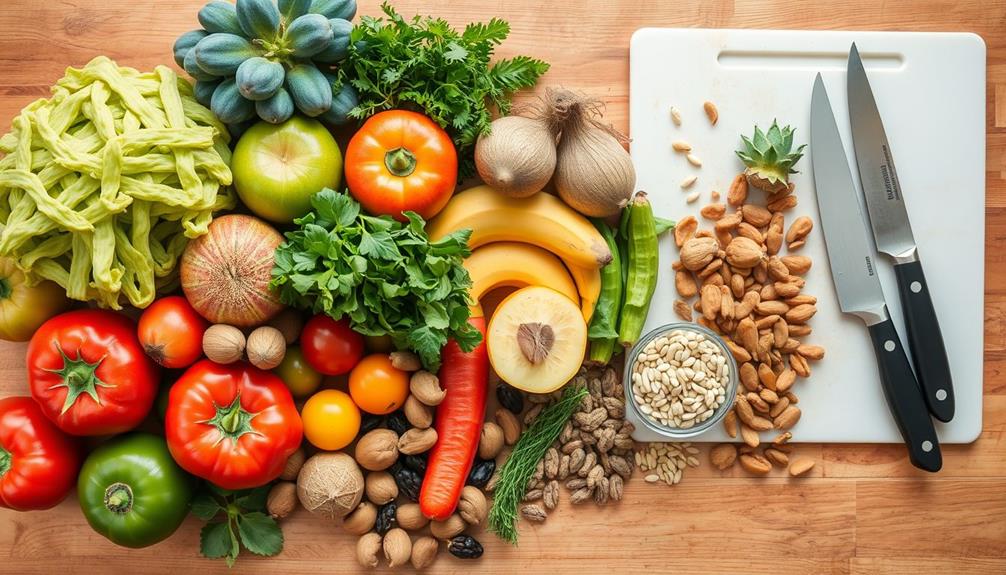
Understanding consumer awareness and safety is crucial for anyone exploring the world of raw foods. While raw fruits and vegetables can be nutritious, they can also pose risks if not handled properly.
Just as individuals with certain emotional disorders, such as BPD, may face challenges in managing their dietary choices, foodborne illnesses, such as E. coli and salmonella, often arise from improper handling and preparation, making it essential for you to stay informed.
Here are some important safety guidelines to take into account:
- Source raw foods from reputable suppliers to guarantee quality.
- Thoroughly wash raw fruits and vegetables to eliminate harmful bacteria and pesticides.
- Avoid consuming raw meat and eggs, as these have a higher risk of contamination.
- Educate yourself on safe consumption practices to reduce health risks.
- Stay updated on evolving safety guidelines and nutritional advice regarding raw diets.
Types of Raw Food Diets

When exploring raw food diets, you'll find several distinct options to choose from. These diets emphasize the consumption of uncooked and unprocessed foods, which can be beneficial for overall health and wellness.
The Raw Vegan Diet sticks to plants only, while the Raw Vegetarian Diet adds eggs and dairy for variety. If you're open to a broader selection, the Raw Omnivorous Diet includes both plant and raw animal products.
Incorporating a balanced diet rich in fruits and vegetables can support your journey towards maintaining health and longevity, as noted in lifestyle for longevity.
Raw Vegan Diet
Often embraced for its health benefits, the raw vegan diet strictly focuses on uncooked, unprocessed plant foods, eliminating all animal products. This plant-based diet is rooted in the belief that cooking destroys crucial nutrients and natural enzymes necessary for ideal health and digestion.
Incorporating foods like herbal teas can complement a raw vegan lifestyle, as they offer relaxation and additional health benefits.
When you adopt a raw vegan diet, you can enjoy a variety of foods and preparation methods, such as:
- Fresh fruits and vegetables
- Nuts and seeds
- Sprouted grains
- Smoothies and juices
- Dehydrated snacks
This diet is rich in vitamins and minerals, promoting increased energy and weight loss while lowering the risk of chronic diseases.
However, it's important to plan your meals carefully, as the raw vegan diet can lead to deficiencies in key nutrients like vitamin B12, iron, and omega-3 fatty acids.
If you're considering this lifestyle, be mindful of these potential challenges, including limited food options and social isolation.
Raw Vegetarian Choices
Raw vegetarian choices expand the variety of foods available in a raw food diet by including unprocessed dairy and raw eggs alongside plant-based ingredients. This raw vegetarian diet emphasizes uncooked fruits, vegetables, nuts, seeds, and sprouted grains while adhering to the principle of not heating foods above 118°F (48°C).
By allowing raw dairy items like cheese and yogurt, you gain nutritional diversity without the need for cooking, making your meals more versatile. Additionally, exploring various brewing methods can complement your raw food experience, especially when paired with raw coffee beverages.
Unlike a strictly raw vegan diet, the raw vegetarian diet offers the inclusion of unpasteurized milk and raw eggs, providing additional sources of protein and essential vitamins. This flexibility can enhance your culinary experience, as you'll be able to experiment with various combinations of raw dairy and plant-based foods.
However, interpretations of the raw vegetarian diet can vary. Some followers might allow for processed or minimally heated foods based on personal preferences.
Ultimately, the key is to maintain the core principles of eating raw while enjoying a broader selection of nutrient-rich options. Embrace these raw vegetarian choices to create satisfying and nourishing meals that align with your dietary goals.
Omnivorous Raw Options
The omnivorous raw food diet presents a diverse array of options that combine uncooked plant-based foods with raw animal products, including meat and dairy. This approach offers a broader range of nutrient sources compared to raw vegan or vegetarian diets, while also emphasizing common financial terms that can help you budget for organic foods.
You can enjoy a variety of unprocessed foods that are high in fiber while also addressing potential deficiencies in vitamin B12, iron, and omega-3 fatty acids.
Here are some common components of an omnivorous raw food diet:
- Fresh fruits and vegetables
- Raw nuts and seeds
- Raw animal products like fish
- Raw eggs (in moderation)
- Dehydrated snacks
Many followers emphasize organic choices and may prepare meals through techniques like blending, juicing, and dehydrating, ensuring food temperatures remain below 118°F (48°C).
While some strictly avoid cooked foods, others might include lightly cooked items occasionally, such as sun-dried tomatoes or roasted nuts. This flexibility allows you to tailor your raw foods diet to your preferences while still reaping the benefits of both plant and animal-based nutrients.
Nutritional Considerations
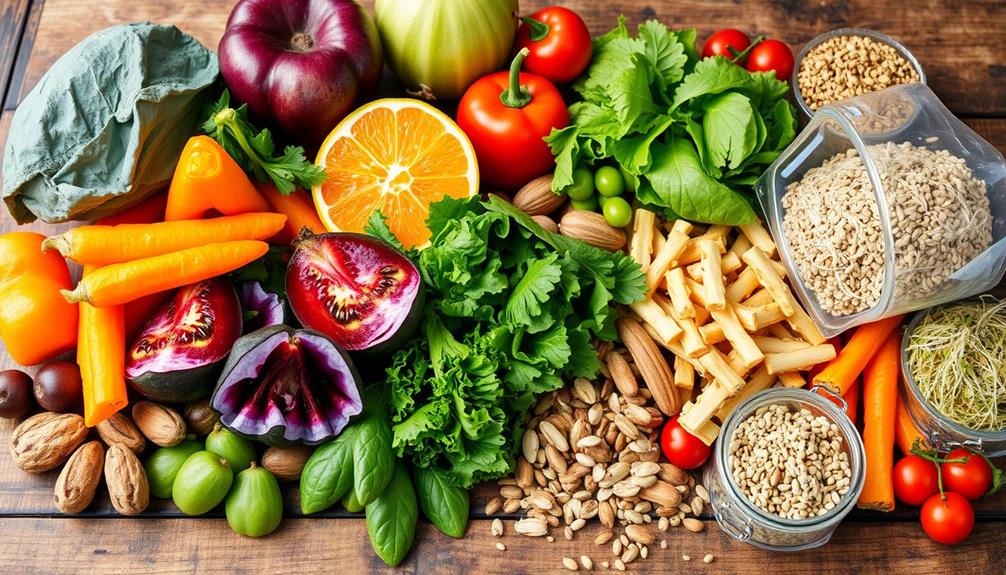
When considering nutritional aspects of a raw food diet, it's vital to recognize its high nutrient density, as it mainly includes fresh fruits, vegetables, nuts, and legumes. These foods are packed with vitamins and minerals essential for your health, promoting overall well-being.
However, the raw food diet can be deficient in key nutrients typically found in animal products, such as protein and vitamin B12. This deficiency necessitates careful dietary planning to avoid potential health issues.
Long-term adherence to this diet might lead to lower bone mass and irregular menstrual cycles in females due to inadequate intake of essential nutrients like iron, calcium, omega-3 fatty acids, and vitamin D.
While the high fiber content in raw foods can help with weight loss by promoting satiety, you may face challenges with limited food options and the need for thorough preparation to guarantee a balanced nutrient profile.
It's also worth noting that cooking can enhance the bioavailability of certain nutrients, such as lycopene and beta-carotene, which may be less accessible in their raw forms.
Consequently, achieving a well-rounded raw food diet requires keen attention to nutritional balance.
Benefits and Drawbacks
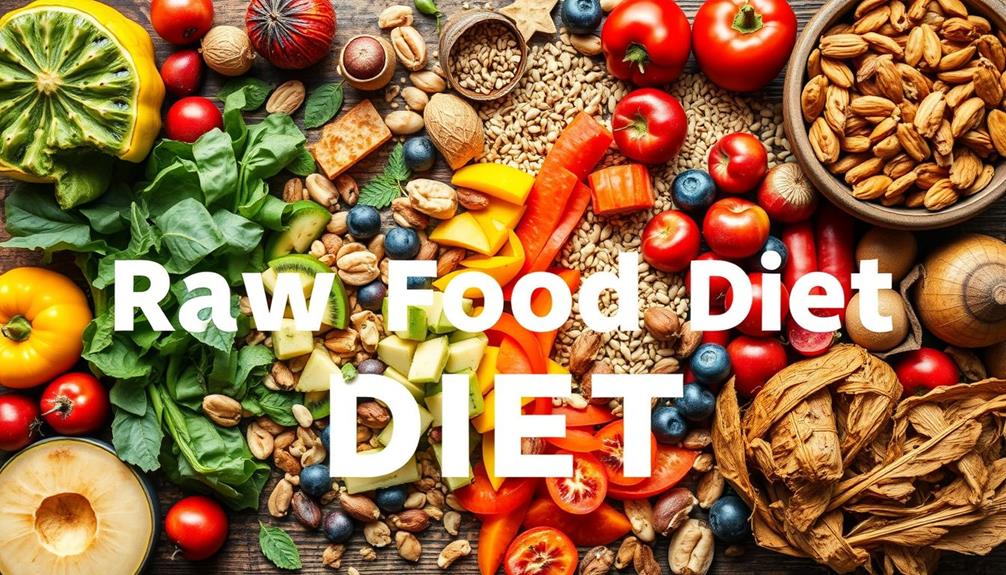
When you consider the raw food diet, you'll find it offers notable health benefits, like increased energy and higher nutrient retention.
However, you also need to be aware of potential nutritional deficiencies and food safety concerns that come with consuming raw foods.
Balancing these factors is essential for making informed dietary choices.
Health Benefits of Raw
Eating raw foods can greatly enhance your nutrient intake, primarily through a diet rich in fruits and vegetables. This approach is linked to numerous health benefits, including lower risks of chronic diseases like heart disease and diabetes.
Plus, raw foods are high in fiber, which aids digestion and can support weight loss due to their lower calorie density.
However, it's important to be aware of the potential drawbacks. Here are some key points to keep in mind:
- Increased consumption of vitamins and antioxidants
- Lower risks of chronic diseases
- Enhanced digestive health through fiber
- Potential for foodborne illnesses (like E. coli and salmonella)
- Risk of nutrient deficiencies, particularly in vitamin B12 and omega-3 fatty acids
While the raw food diet offers impressive health benefits, you need to be strategic in your planning.
Make certain you're getting a balanced intake of essential nutrients while avoiding the pitfalls of foodborne illnesses. Emphasizing hygiene and sourcing your ingredients from reputable suppliers can help mitigate these risks, allowing you to enjoy the advantages of a raw food lifestyle effectively.
Nutritional Deficiencies Risks
While the raw food diet offers numerous health benefits, it's important to be aware of the potential nutritional deficiencies that can arise. One major concern is vitamin B12, which is primarily found in animal products; without careful meal planning, you may lack this vital nutrient.
Additionally, deficiencies in calcium and vitamin D can lead to lower bone mass, as indicated by a 2005 study on long-term raw food vegetarians.
You might also struggle to get enough protein and omega-3 fatty acids, essential for overall health and found mainly in fish and other animal sources. A diet high in raw foods can lead to reduced calorie intake, complicating your nutritional adequacy and energy levels.
Moreover, certain raw foods might hinder nutritional absorption, which can cause dental erosion and menstrual irregularities in women over time.
While the raw food diet promotes high fiber intake, it can result in deficiencies in essential nutrients if you don't diversify your meals properly. To maintain a balanced nutrient profile, you'll need to focus on strategic meal planning that includes a wide variety of foods.
Food Safety Concerns
Food safety is an essential aspect to take into account with a raw food diet, as it can expose you to higher risks of foodborne illnesses. Certain raw foods, like meat, eggs, and dairy, can harbor harmful pathogens, leading to serious health issues.
Here are some key concerns:
- E. coli and salmonella are common risks associated with raw animal products.
- Raw fruits and vegetables can carry bacterial contamination if not properly washed.
- Raw pet foods can pose health risks to both pets and humans, particularly vulnerable groups.
- Cross-contamination in the kitchen can exacerbate food safety issues, so be mindful of safe handling practices.
- Specific items like raw sprouts and certain legumes require careful preparation to avoid severe foodborne illnesses.
To enjoy a raw food diet safely, prioritize proper washing and sanitizing of food, clean utensils and surfaces thoroughly, and store leftovers correctly.
Staying informed about the risks associated with raw foods helps you make safer choices, ensuring a balanced approach to health and nutrition.
Always remember that food safety is a shared responsibility; you play a vital role in preventing foodborne illnesses.
Practical Tips for Beginners
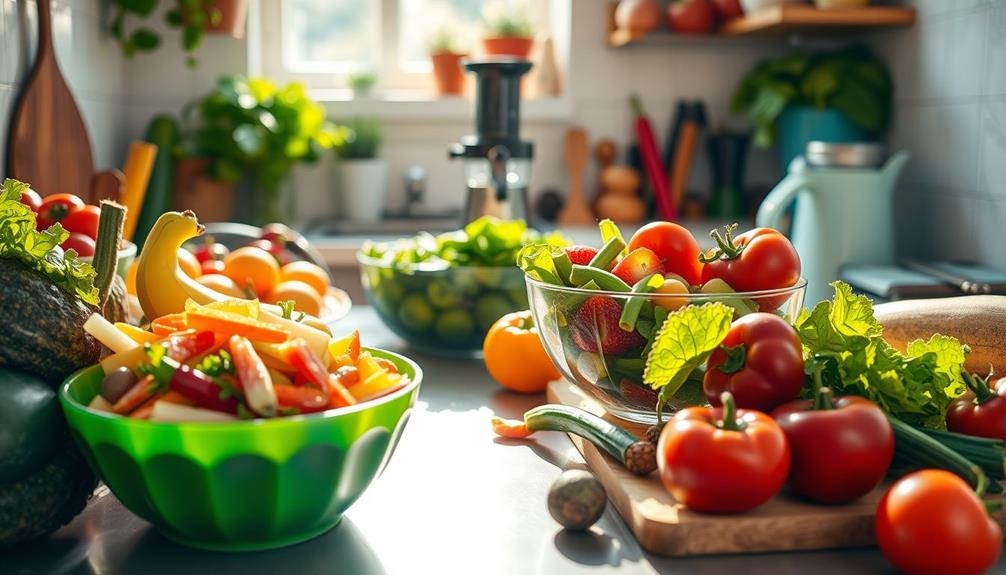
Shifting to a raw food diet can feel overwhelming at first, but starting gradually makes it much easier. Begin by incorporating more raw foods into your daily meals. Fresh fruits, crisp salads, and nutrient-packed smoothies are great choices to ease your change.
Investing in essential kitchen tools like a high-quality blender, food processor, and dehydrator can greatly enhance your meal preparation experience. These gadgets help you explore a variety of textures and flavors, making eating raw foods enjoyable.
Focus on seasonal produce, sourcing locally whenever possible. This not only maximizes flavor and nutrition but also reduces your exposure to pesticides.
Don't hesitate to seek support. Joining online communities or local groups dedicated to raw food enthusiasts can provide you with valuable recipe ideas and tips for meal planning.
Research and Dietary Trends
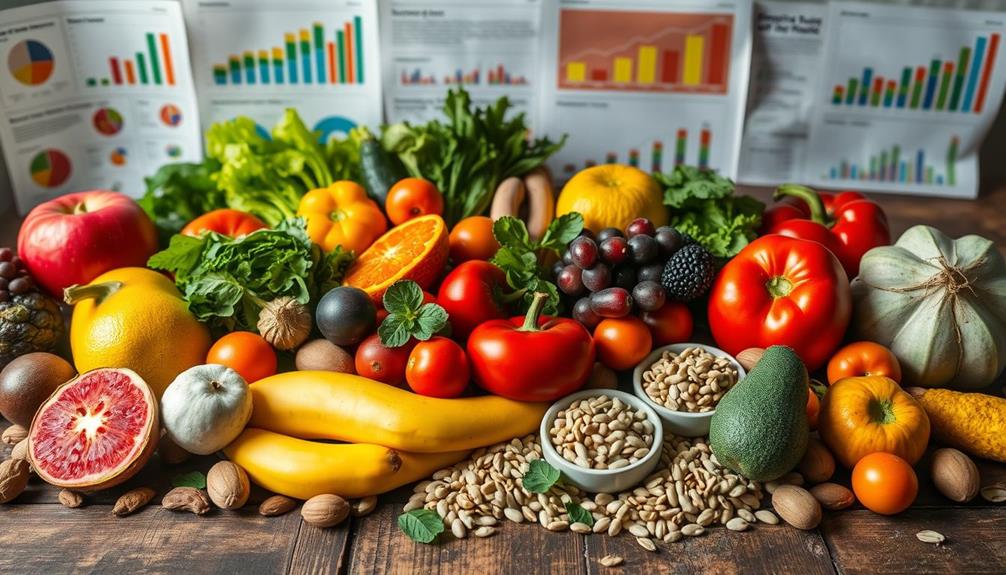
The raw food diet's appeal lies in its emphasis on natural, unprocessed ingredients that promise health benefits. By focusing on fruits, vegetables, nuts, seeds, and sprouted grains, this diet aims to preserve essential nutrients and enzymes.
Research indicates that a high intake of raw foods can lower the risk of chronic diseases, such as heart disease and diabetes, thanks to their nutrient-rich, low-calorie profiles. Here are some key points about the raw food diet and its trends:
- Prioritizes uncooked, whole foods
- Retains water-soluble vitamins while cooking enhances others
- Often compared to vegan and Mediterranean diets
- Linked to lower risk of chronic diseases
- Requires a balanced approach to nutrient intake
While the raw food diet has its merits, ongoing studies are fundamental to validate its health claims and understand long-term impacts.
It's significant to take into account that both raw and cooked foods can play an important role in your diet. By incorporating a variety of food preparation methods, you can maximize health benefits while enjoying a diverse range of flavors and textures.
Frequently Asked Questions
What Is the Overview of Raw Food Diet?
The raw food diet focuses on uncooked, unprocessed foods like fruits, vegetables, nuts, and seeds. You'll experience potential health benefits, but be mindful of nutritional deficiencies and consider planning your meals carefully. For some, the raw food diet may offer increased energy, improved digestion, and weight loss. However, it’s essential to be aware of potential risks, such as a lack of essential nutrients like protein, calcium, and vitamin B12. Educating yourself about raw food diet insights and facts can help you make informed decisions about your dietary choices and ensure that you are meeting your nutritional needs. Consulting a healthcare professional or nutritionist can also provide guidance and support as you navigate the raw food diet.
What Is Raw Food Explanation?
Raw food consists of uncooked, unprocessed foods that aren't heated above 115°F. You enjoy fruits, vegetables, nuts, and seeds, as they retain natural enzymes and nutrients, potentially boosting your energy and overall health.
What Is Considered Raw Food?
Raw food includes uncooked fruits, vegetables, nuts, seeds, and sprouted grains. You might also consider unpasteurized dairy and certain processed items like cold-pressed oils or dried fruits, as long as they're not heated.
What Is the Comprehensive Definition of Food?
Food's a vibrant tapestry, weaving together flavors and nutrients. It's any substance you consume, supplying your body with energy and sustenance. From fruits to grains, each bite plays a role in your health journey.
Conclusion
Incorporating raw foods into your diet can be a rewarding journey, but it's crucial to stay informed. For instance, consider Sarah, who switched to a raw food diet and experienced increased energy and improved digestion. However, she also faced challenges with ensuring balanced nutrition. By being mindful of both the benefits and potential pitfalls, you can make empowered choices that enhance your health while enjoying the vibrant flavors of raw foods. Embrace the adventure with caution!

